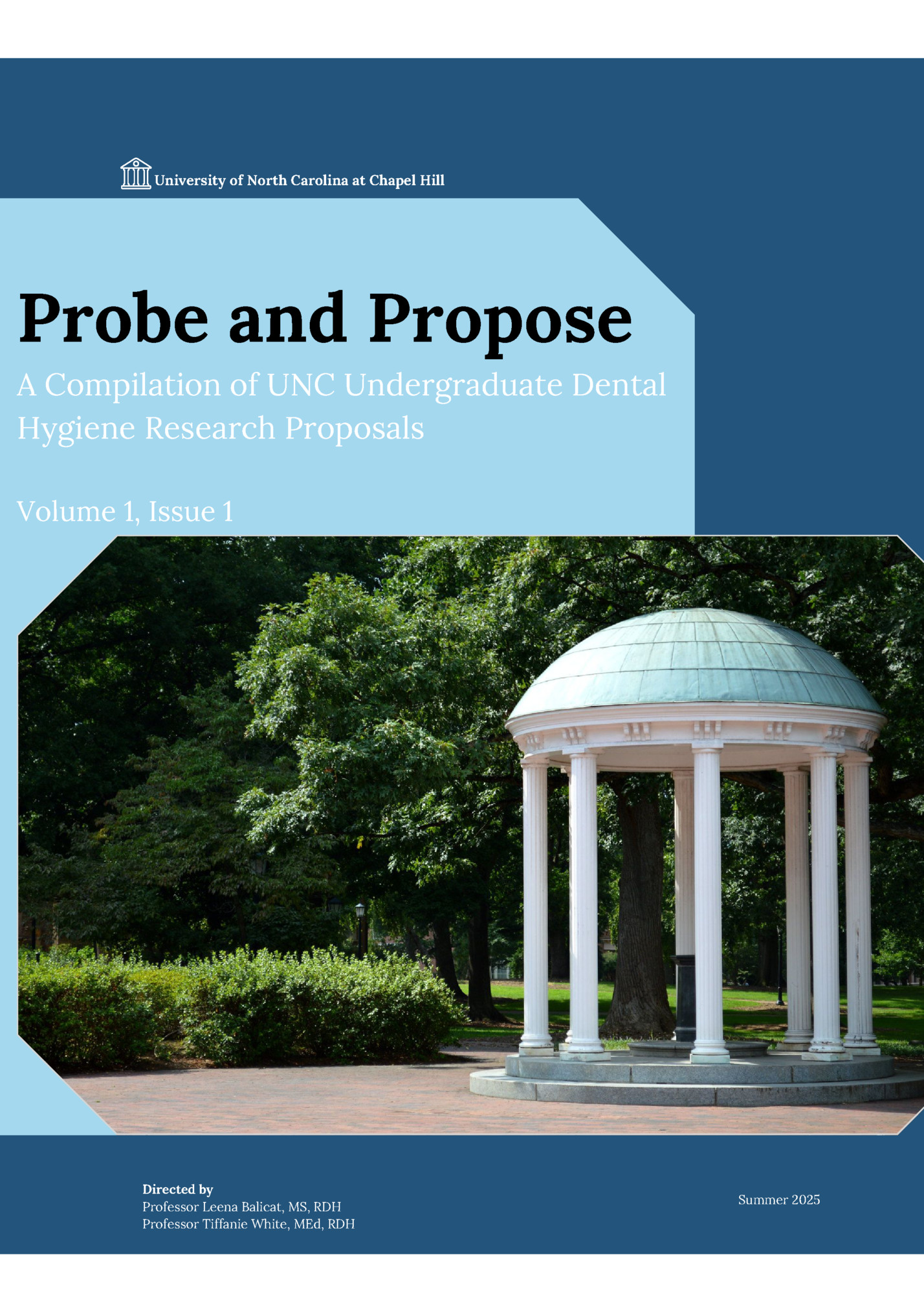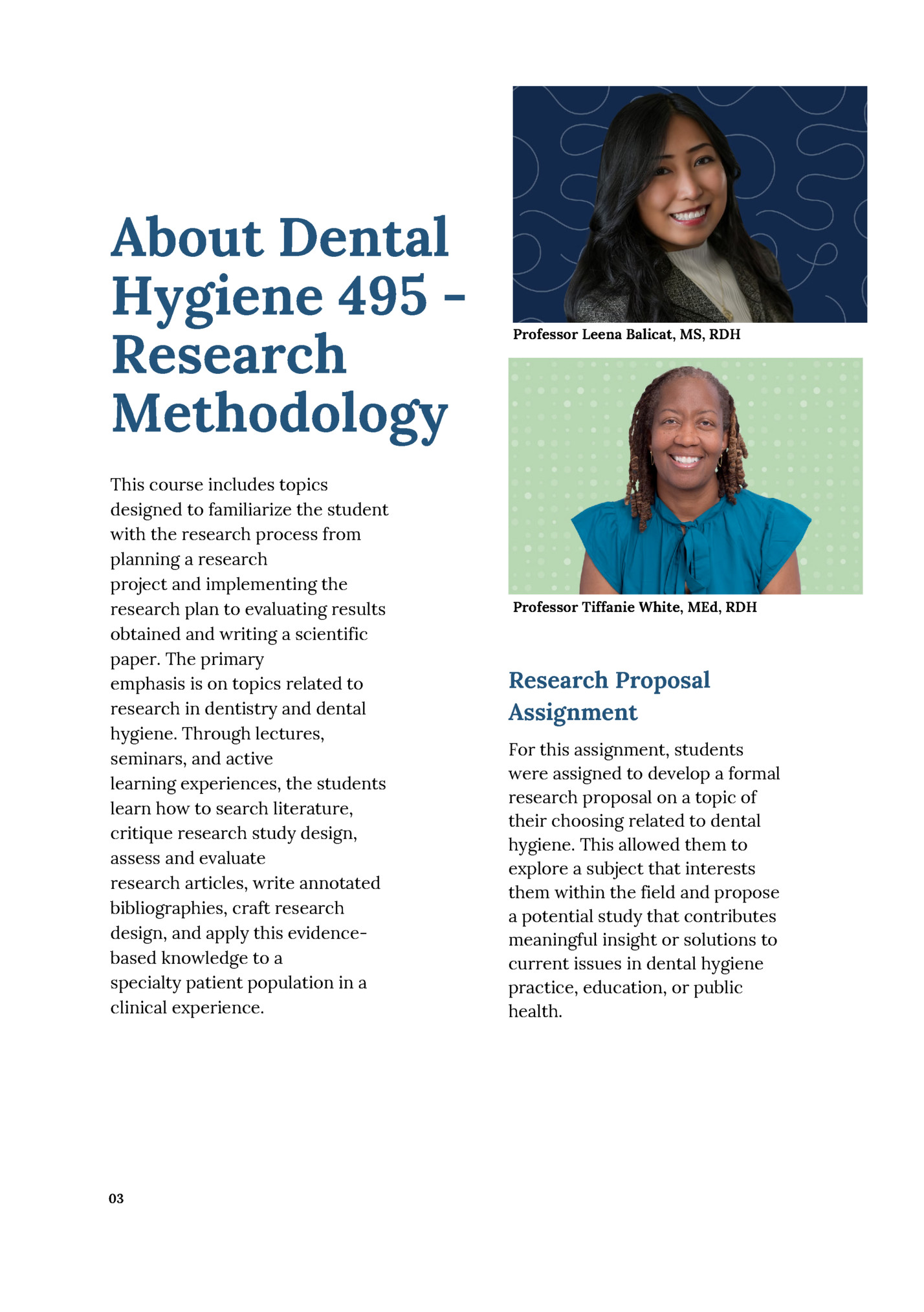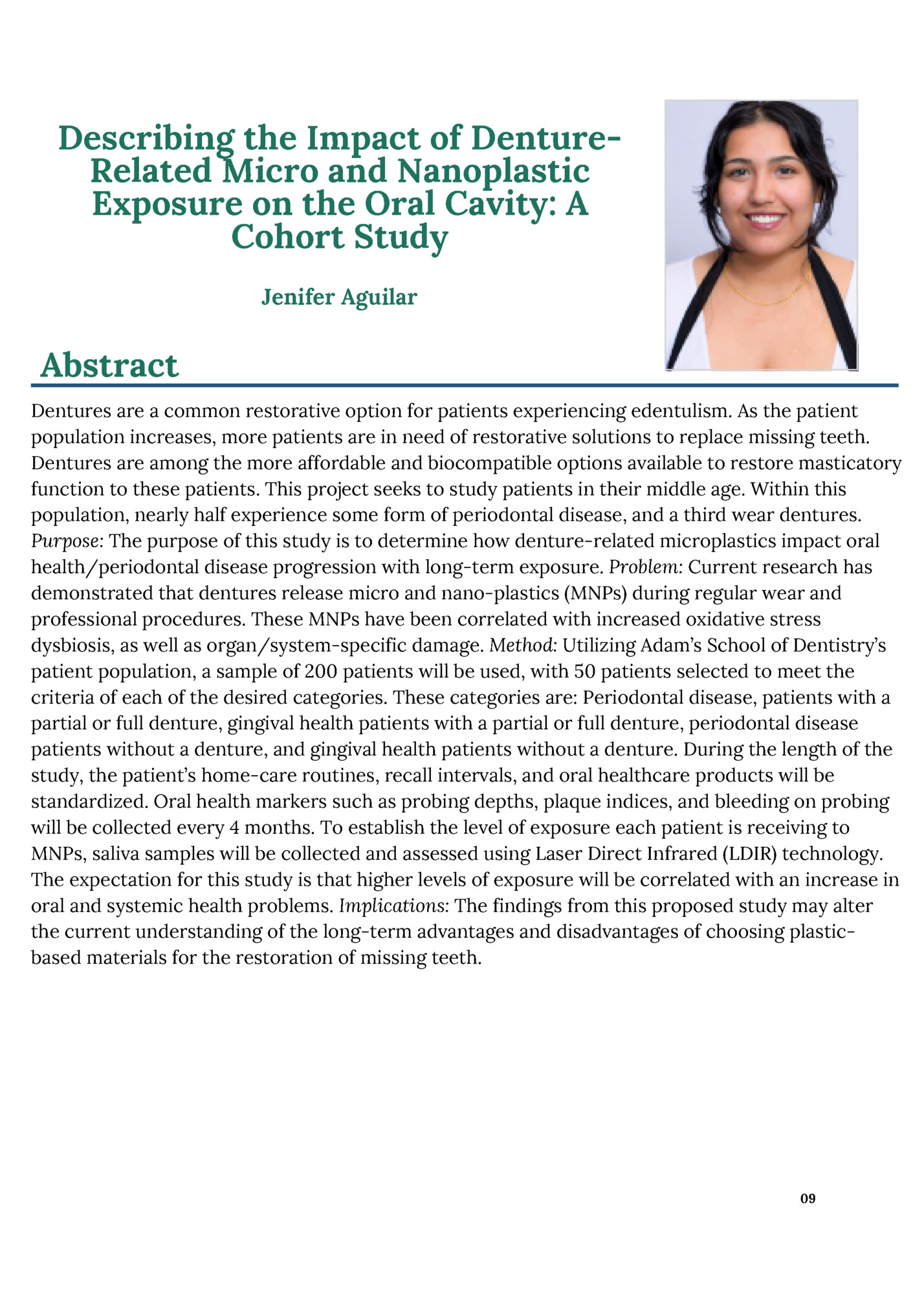Probe and Propose A Compilation of UNC Undergraduate Dental Hygiene Research Proposals Volume 1, Issue 1 Directed by Professor Leena Balicat, MS, RDH Professor Tiffanie White, MEd, RDH Summer 2025

About DHYG 495 Student Directory Abstracts 03 05 09 02

Hygiene 495 Research Methodology This course includes topics designed to familiarize the student with the research process from planning a research project and implementing the research plan to evaluating results obtained and writing a scientific paper. The primary emphasis is on topics related to research in dentistry and dental hygiene. Through lectures, seminars, and active learning experiences, the students learn how to search literature, critique research study design, assess and evaluate research articles, write annotated bibliographies, craft research design, and apply this evidencebased knowledge to a specialty patient population in a clinical experience. 03 Professor Leena Balicat, MS, RDH Professor Tiffanie White, MEd, RDH Research Proposal Assignment For this assignment, students were assigned to develop a formal research proposal on a topic of their choosing related to dental hygiene. This allowed them to explore a subject that interests them within the field and propose a potential study that contributes meaningful insight or solutions to current issues in dental hygiene practice, education, or public health.

Directory

Describing the Impact of Denture- Related Micro and Nanoplastic Exposure on the Oral Cavity: A Cohort Study Jenifer Aguilar (Page 9) Effectiveness of Fluoride Varnish vs. Dental Sealants in Children and Adolescents The Long-Term Effects of Vaping in Relation to Oral Health Derwin Bowser Jr. (Page 10) Erin Bullock (Page 11) Prevalence and Severity of Xerostomia in Young Adults Who Vape Mind Over Mouth: Investigating the Effects of Depression on Dental Health in Adults Efficacy of Oil Pulling Therapy Versus Conventional Mouthwashes for the Treatment of Gingivitis Avery Ellis (Page 12) Tia Exume’ (Page 13) The Effects of Access to Dental Care on Dental IQ in Stokes County, North Carolina Oral and Overall Health: Evaluating the Impact of Chewing Gum in Improving Children's Oral Health Presley Hartle (Page 15) Sydney Hlavacek (Page 16) 05 Austin Ferry (Page 14) The Impact of TeledentistryBased Oral Hygiene Instructions on Oral Health and Patient Compliance in Children from Underserved Communities Darlette Lopez-Maria (Page 17)

Oral Health in Children: The Effect of Motivational Tools Abigail Macedo (Page 18) Tracking Toward Better Oral Health: Smart vs. Manual Toothbrush Use in Special Needs Populations Language Barriers Effect on Oral Health Courtney Mauldin (Page 20) Shauntel Matthews (Page 19) Makenzie Montgomery (Page 21) Evaluating the Effect of Dental Hygienist-Provided Periodontal Therapy on Pregnancy Outcomes The Effects of Social Media on Oral Hygiene: The Need for Oral Health Care Provider Guidance Mary Beth Moss (Page 22) Tyler Petlick (Page 23) Dental Hygiene Knowledge: Evaluating The Information and Practices of College-Age Students in Dental Care Gap Regions Comparing the Effects of Newer Tobacco Products Versus Traditional Tobacco Products: Periodontal Health Consumer Perception and Market Adoption of NanoHydroxyapatite Toothpaste Sophia Petrini-Poli (Page 24) Noel Rangel (Page 25) What is the impact of oral hygiene practices on quality of life among elderly adults in long-term care facilities? 06 Isabel Rodriguez Cruz (Page 26)

Oral Health Outcomes in Plant-Based vs. Omnivorous Diets: A Comparative Analysis Carbohydrate Consumption Affecting Athletes Performance and Caries Risk Musculoskeletal Disorder Interventions in Dental Hygiene: Efficacy of The Saddle Stool Whitney Toler (Page 27) Kelley Topiwala (Page 28) Alyssa Wang (Page 29) 07


Exposure on the Oral Cavity: A Cohort Study Jenifer Aguilar Abstract Dentures are a common restorative option for patients experiencing edentulism. As the patient population increases, more patients are in need of restorative solutions to replace missing teeth. Dentures are among the more affordable and biocompatible options available to restore masticatory function to these patients. This project seeks to study patients in their middle age. Within this population, nearly half experience some form of periodontal disease, and a third wear dentures. Purpose: The purpose of this study is to determine how denture-related microplastics impact oral health/periodontal disease progression with long-term exposure. Problem: Current research has demonstrated that dentures release micro and nano-plastics (MNPs) during regular wear and professional procedures. These MNPs have been correlated with increased oxidative stress dysbiosis, as well as organ/system-specific damage. Method: Utilizing Adam’s School of Dentistry’s patient population, a sample of 200 patients will be used, with 50 patients selected to meet the criteria of each of the desired categories. These categories are: Periodontal disease, patients with a partial or full denture, gingival health patients with a partial or full denture, periodontal disease patients without a denture, and gingival health patients without a denture. During the length of the study, the patient’s home-care routines, recall intervals, and oral healthcare products will be standardized. Oral health markers such as probing depths, plaque indices, and bleeding on probing will be collected every 4 months. To establish the level of exposure each patient is receiving to MNPs, saliva samples will be collected and assessed using Laser Direct Infrared (LDIR) technology. The expectation for this study is that higher levels of exposure will be correlated with an increase in oral and systemic health problems. Implications: The findings from this proposed study may alter the current understanding of the long-term advantages and disadvantages of choosing plasticbased materials for the restoration of missing teeth. 09

Fleepit Digital © 2021